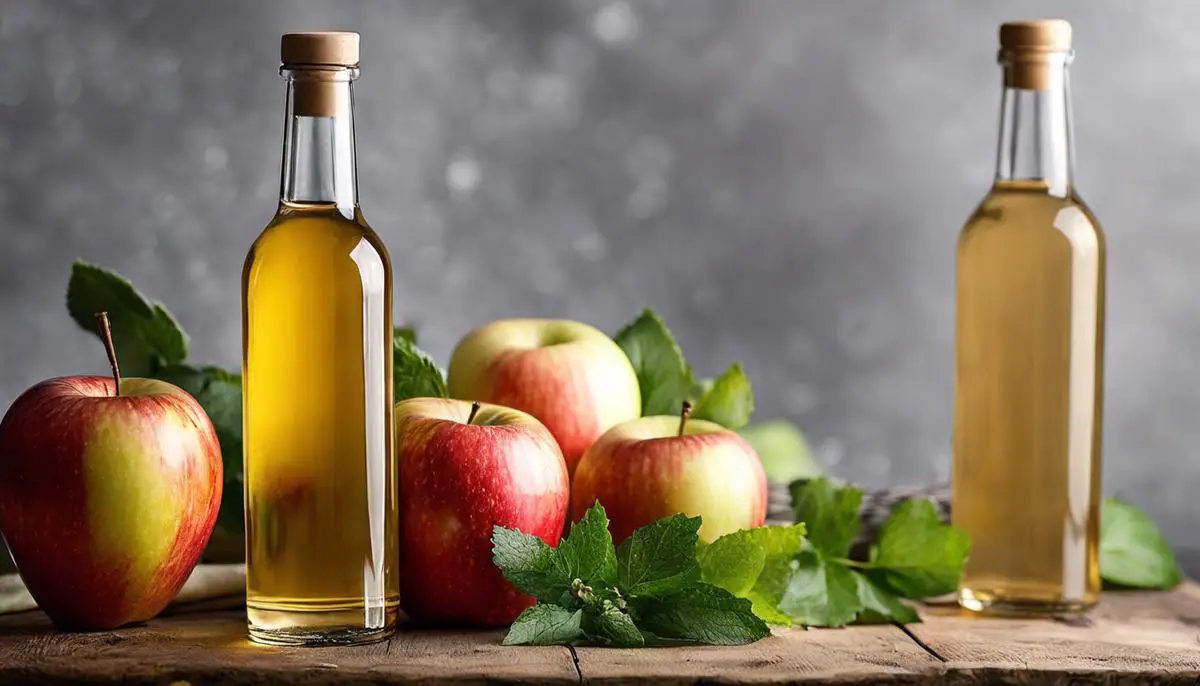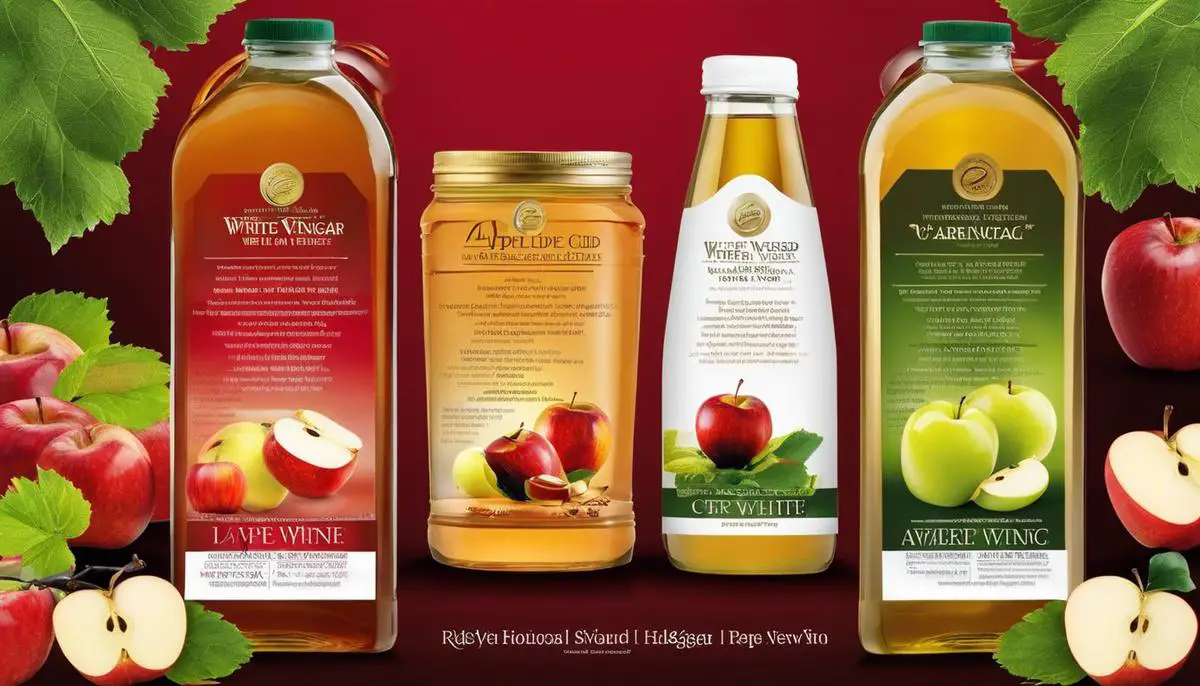Vinegar, though a simple ingredient, is one that varies greatly in type and uses – turning ordinary dishes into gastronomic delights. Among the many varieties, Apple Cider Vinegar and White Wine Vinegar have always sparked curiosity thanks to their savory tang and myriad health benefits. This exploration will delve into the production methods, unique characteristics, and flavor profiles of these two vinegars, shedding light on the keys to their flavor – apples and grapes. Beyond their culinary uses, the article will also uncover the health benefits and nutritional differences between these two kinds of vinegar, aiming at equipping the readers with knowledge to make informed decisions in their cooking and wellness routines.
Understanding Vinegar Varieties
Unveiling The Vinegar Varieties: A Deeper Look into White Wine & Apple Cider Vinegar
The thrilling world of culinary marvels caters to an extensive array of tastes, textures, and colors, spinning a delightful web of culinary intrigue and excitement. The essence of flavor, representation of culture and tradition, and the fascinatingly wholesome, gastronomic experience it provides draws us all together like nothing else. Among the key elements that stand out in our culinary endeavors are the versatile vinegars. Today, let us explore two particular categories of vinegar, Apple Cider Vinegar and White Wine Vinegar.
White Wine Vinegar, often considered a staple in the pantries of many culinary enthusiasts, is known for its light and tangy taste. It’s a product of fermenting white wine, which might feel like a fancy touch in a bottle. However, it’s the unique production methods that make it so distinct. The process commences with the bacterial activity on the wine, converting the alcohol into acetic acid. The end result is a vinegar that boasts a subtle color and bright, crisp flavor, ideal for enhancing the taste of various dishes.
White Wine Vinegar comes with its unique touch and serves versatile uses. Its great ability to cut through rich, oily flavours makes it ideal for marinades and vinaigrettes. It plays out perfect harmony with its acidic nature in salad dressings, enhancing the freshness with just the right amount of zing. Be it a drizzle over your favorite greens or a touch in your seafood dishes, it’s that ingredient elevating your culinary arts.
On the other hand, Apple Cider Vinegar, often abbreviated as ACV, brings out a completely different profile both in production and usage. The main ingredient being apples, the process starts with crushing fresh apples to extract the juice. This juice then undergoes a two-step fermenting process, where it gradually transforms into vinegar. Yeast is first added to the fresh apple juice to kick-start the fermentation process and converts the sugars into alcohol. Further, bacteria are introduced to ferment the alcohol into acetic acid, creating the signature strong, tart taste of ACV.
Unlike White Wine Vinegar, the fruity undertones of Apple Cider Vinegar offer a distinct flavor layer to applications way beyond just culinary. Besides lending the tangy touch to your marinades and dressings, it’s become increasingly popular for its potential health benefits. From aiding digestion to improving skin health, ACV has nestled its place in most homes for reasons more than just flavor.
Though both these vinegars share a similar sourness due to their common primary compound, acetic acid, their distinct flavors vary vastly. While White Wine Vinegar brings a delicate, slightly sweet flavor, Apple Cider Vinegar carries a robust, fruity tartness. Hence, while the former is preferred for light and savory dishes, the latter fits well in robust, heartier meals and health recipes.
Choosing between these two really depends on the flavor profile you’re after and the dish you’re preparing. They both offer their own charm and, frankly, have earned their places in every food lover’s kitchen. So get experimenting, fellow food adventurers, for the world of vinegar holds so much more than what meets the eye!

The Culinary Use of Vinegar
To the casual observer, it may seem perplexing that so much care and deliberation goes into the selection of something as seemingly simple as vinegar. Yet, ask any food enthusiast or professional chef and they will enthusiastically enlighten you about how different vinegars can remarkably enhance the flavor of our meals, the potential variations blowing your taste buds into culinary nirvana. Specifically, when it comes to White Wine Vinegar and Apple Cider Vinegar, there’s a world of difference that extends beyond just prompt culinary preferences.
While we’ve already set sail to understand their production methods and basic applications, let’s delve deeper into the distinctive attributes that render each of them unique.
White Wine Vinegar, revered for its sharp, and robust flavor, boasts an acidic bite that accentuates the taste of certain fish, poultry, and vegetable dishes. It’s capable of breaking down the fibers in meat and makes for an ideal tenderizing marinade. It’s also commonly used for deglazing pans, or whipped into a Hollandaise sauce best paired with artichoke or asparagus. These subtle nuances can elevate familiar foods to new sensory realms, creating palatable experiences to dig into.
Then we have Apple Cider Vinegar, the darling of home cooking and natural health advocates owing to its wider range of health benefits. Its mild, fruity flavor is a great complement to hearty autumn foods, lending the right amount of acidity to offset the sweetness in dishes. Think of stews, chutneys, and braised meat where a splash of it can brighten up the ingredients, bestowing a well-balanced, sweet-sour tang.
Notably, the Apple Cider Vinegar has a completely different function in baking as compared to its ability to marinate meat or dress salads. When added to baking recipes with the likes of cookie dough or pastries, it acts as a leavening agent, providing fluffiness and tenderness to the finished product, proving that its versatility knows no bounds in the culinary world.
In the end, though, it all boils down to personal preference. Is a bolder, tangier taste preferred for the shrimp dish you’ve been planning for your weekend party? Use White Wine Vinegar. Or is it a slightly sweet and mellow acidity that’s needed to brighten up your slowly simmered chili? Apple Cider Vinegar is your friend.
So, where does this vinegar voyage leave us? Quite simply, it underscores the beauty of culinary creativity. There’s no one-size-fits-all mandate when it comes to choosing vinegars. Both White Wine Vinegar and Apple Cider Vinegar can burst forth onto your culinary stage, playing sturdy supporting roles and assisting you to make each bite more memorable than the last one. Here’s to endless taste adventures on your cooking journey!

Health Benefits and Nutritional Differences
Diving deeper into the secret kitchen arsenal of vinegars, it’s pivotal we examine the health benefits and nutritional differences between these culinary stars – Apple Cider Vinegar and White Wine Vinegar. This exploration doesn’t just steep in curiosity, it carries practical implications for your overall wellness and, arguably, the quality of your food.
Regarding nutritional content, surprisingly, these vinegars are near identical twins – both are low in calories yet relatively high in acetic acid. This humble compound – easily overlooked amidst the flavors jazzing around your dish – plays a medley of heart-protective roles, aiding in controlling blood sugar levels, improving digestion, and even supporting weight loss. It’s the secret solo artist, enhancing your dish while caring for your health.
Yet, while they share a base beat, Apple Cider Vinegar and White Wine Vinegar express their nutritional symphony differently. Apple Cider Vinegar, enriched with apple extracts and juice, claims the crown in regards to vitamins and nutrients. It’s rich in vitamin C, the antioxidant mastermind fighting against cellular damage, and boosts the immune system through its vitamin B1 and biotin content. Potassium, a mineral essential for heart function, helps with fluid balance and muscle contraction, also announces its presence in this beloved vinegar.
With White Wine Vinegar, it turns down the volume on the mineral jam and amps up the acetic acid. A glass of White Wine Vinegar holds more of this metabolic maestro, making it a prized partner for health-conscious food enthusiasts seeking to tap into the benefits of increased acetic acid.
In terms of health benefits, Apple Cider Vinegar seems a culinary phoenix, claimed to help lower cholesterol levels, improve skin health, and even soothe a sore throat. Many swear by its elixir-like properties, incorporating it into daily wellness routines, and exploring its transformative potential.
On the other hand, White Wine Vinegar celebrates a more subtle health ethos focusing more on digestive aid. Rich in probiotics and beneficial bacteria, it’s the go-to gut health enhancer, helping improve your healthy bacteria balance. Plus, it’s linked to better nutrient absorption.
One isn’t inherently better than the other; they just play different tunes. Apple Cider Vinegar strums the heartstrings of health enthusiasts with its nutrient-dense profile and potential health benefits, while White Wine Vinegar flaunts its acetic acid content and charming pairing with food.
Rather than a competition, imagine these vinegars as two musicians in concert – their distinctions creating a grander symphony of flavor and wellness. Embrace their unique traits, both in your cooking and for your wellbeing. Select your vinegar not just on flavor, but also with an ear for the nutritional melodies they add to your plate. Because when culinary creativity and health benefits align, that’s when the real magic happens in the kitchen.

Whether you are a home cook, a culinary expert, or someone embarking on a journey toward better health, understanding the differences between White Wine Vinegar and Apple Cider Vinegar is of paramount importance. Each carries a distinctive set of tastes, culinary applications, health benefits, and nutritional content. Armed with this detailed understanding, you can now enhance your culinary creations, vary your dressings, improve your pickling, and transform your baking. Moreover, you can make mindful decisions about your consumption, aligning your vinegar choices with your overall nutritional needs and health objectives. Remember, knowledgeable choices are always the healthiest ones.